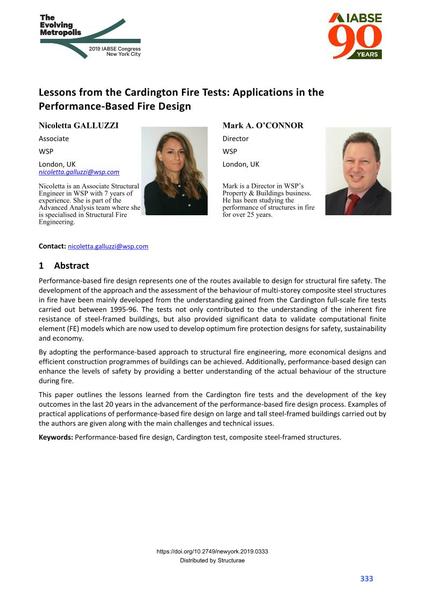Lessons from the Cardington Fire Tests: Applications in the Performance-Based Fire Design

|
|
|||||||||||
Bibliografische Angaben
| Autor(en): |
Nicoletta Galluzzi
(WSP)
Mark A. O'Connor (WSP) |
||||
|---|---|---|---|---|---|
| Medium: | Tagungsbeitrag | ||||
| Sprache(n): | Englisch | ||||
| Tagung: | IABSE Congress: The Evolving Metropolis, New York, NY, USA, 4-6 September 2019 | ||||
| Veröffentlicht in: | The Evolving Metropolis | ||||
|
|||||
| Seite(n): | 333-338 | ||||
| Anzahl der Seiten (im PDF): | 6 | ||||
| DOI: | 10.2749/newyork.2019.0333 | ||||
| Abstrakt: |
Performance-based fire design represents one of the routes available to design for structural fire safety. The development of the approach and the assessment of the behaviour of multi-storey composite steel structures in fire have been mainly developed from the understanding gained from the Cardington full-scale fire tests carried out between 1995-96. The tests not only contributed to the understanding of the inherent fire resistance of steel-framed buildings, but also provided significant data to validate computational finite element (FE) models which are now used to develop optimum fire protection designs for safety, sustainability and economy. By adopting the performance-based approach to structural fire engineering, more economical designs and efficient construction programmes of buildings can be achieved. Additionally, performance-based design can enhance the levels of safety by providing a better understanding of the actual behaviour of the structure during fire. This paper outlines the lessons learned from the Cardington fire tests and the development of the key outcomes in the last 20 years in the advancement of the performance-based fire design process. Examples of practical applications of performance-based fire design on large and tall steel-framed buildings carried out by the authors are given along with the main challenges and technical issues. |
||||
